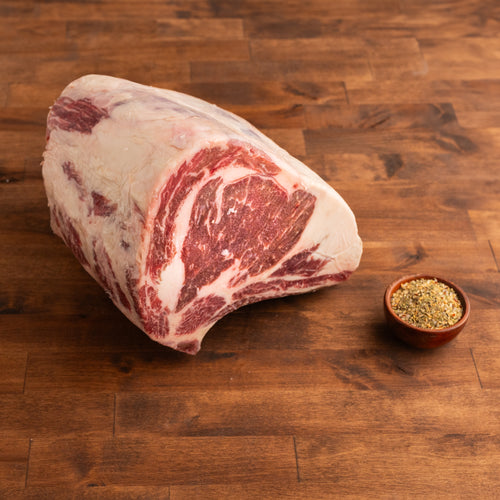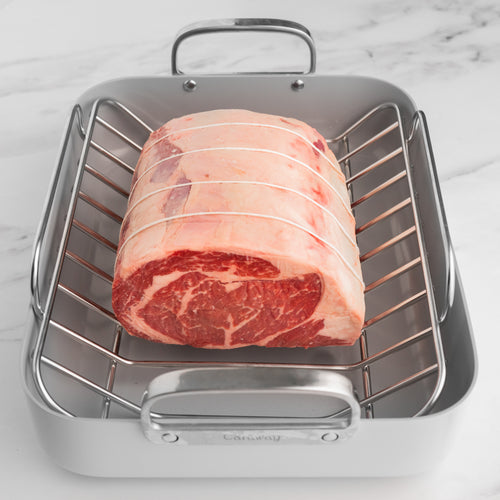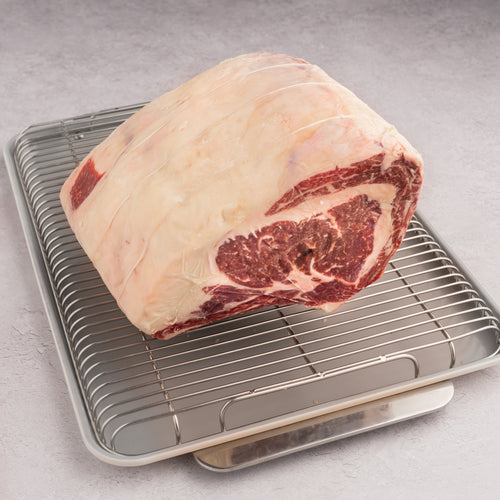
Fool Proof Prime Rib
Chef Edward Higgins' tried-and-true method will turn you into a holiday hero. What a dilemma. Prime rib is the ultimate holiday showstopper, yet it’s laden with heartbreak potential — and Edward Higgins, executive chef at The Lively in Boise, Idaho, thinks he knows why.
People Follow instructions on the Internet," He says, "and calculate oven temperature and time based upon the weight of the meat.
It’s time to throw out what you thought you knew about prime rib and start from scratch, and Higgins is just the chef to help you see the light. He honed his prime rib technique at Bix, a Financial District mainstay in San Francisco, and as a consultant at RingSide Steakhouse in Portland, which was a favorite of no less than James Beard himself. Both adhered to the low-and-slow method he’s laid out here. This method ticks all the boxes, including a crackling, flavorsome crust and a tender, juicy center.
Aside from an excellent-quality prime rib, you’ll need a highly accurate instant-read thermometer with a long probe, such as a Thermapen® ONE Digital Themometer.

Step 1: Properly Thaw Your Prime Rib.
Prime rib should be thawed slowly. Set the prime rib on a plate or tray to catch any liquid, then leave it in the refrigerator. A good rule of thumb is to allow 6 hours per pound.
Step 2: Season Liberally
Season thawed prime rib liberally. “I just use a very simple steak seasoning,” Higgins says. “Garlic, onion, paprika, a little bit of sugar, salt, and pepper.” If you’re using a very rich cut like the SRF Gold pictured here, Higgins suggests minimalism — salt and pepper, or even just salt. Kosher salt or finely ground sea salt is best. You want to be liberal with your seasoning but avoid adding so much that it creates a salt crust.
Cooking low and slow, then doing a final sear make a perfect prime rib.
Step 3: Let It Sit
Place seasoned prime rib in the fridge, uncovered, for 24 hours. This will help create the coveted prime rib crust. “What you’re essentially trying to do is evaporate the moisture content in the surface of the meat,” he says. “By letting it sit in the fridge overnight, you’re giving it a head start.”
Step 4: Prep Your Prime Rib for Prime Time
Two hours before you begin cooking, take the prime rib out of the refrigerator and let it sit at room temperature. This will help it cook more evenly.
Step 5: Set the Temp.
While the prime rib is tempering, set the oven to 275°F. If you have a convection or combination oven, be sure the fan is off — it can raise the heat too much.
Step 6: Start Cooking
Set the prime rib on a roasting rack set in a large pan. Place the prime rib and rack in the oven. Begin checking the prime rib’s temperature after 90 minutes by inserting the instant-read thermometer into the center of the prime rib; the meat should register around 75°F. Check again in another 45 minutes to an hour. Your ultimate goal is 115°F, which may take between 15 to 45 minutes of additional cooking.
Step 7: Remove and Rest
A large cut like a prime rib will continue cooking for quite a while after it has been removed from the oven. So once the thermometer registers 115°F, pull it out and tent the prime rib in aluminum foil. Higgins recommends resting the prime rib for 90 minutes.
Step 8: Sear
While the prime rib is resting, heat the oven to 475°F. Once the oven is hot, place the prime rib back on the roasting rack and place in the oven for 10 to 15 minutes, or until the roast is an even dark brown.
Resting = a juicer prime rib.
Step 9: Slice, Finish, and Serve
Let the prime rib rest another 10 minutes before slicing it. Add a sprinkle of finishing salt to the entire roast. Higgins recommends using a long, thin blade, no more than ¾-inch high, and following along the rib bones to cut ½-inch slices of beef.
Separate the ribs from the bones, then add them back into the roasting pan and into the oven until they are crispy.
Plate the crispy bones and the sliced beef. Then, add another sprinkle of finishing salt to the sliced beef and finish with high-quality olive oil (Higgins likes Basilico from Sicily).

Want to Master Prime Rib?
For more tips on creating the perfect prime rib, check out our Ultimate Christmas Prime Rib Dinner Guide or dive into our Complete Guide on How to Cook Prime Rib.
And don’t forget to watch this embedded video on the most important step: getting the correct internal temperature!
Order Your Prime Rib Today
Make your meal unforgettable with a show-stopping prime rib centerpiece. Here’s a quick guide to help you choose the best Snake River Farms prime rib:
Wagyu Boneless Prime Rib
Easy to carve and perfect for buffets or smaller gatherings where convenience matters.
Shop Boneless Wagyu Prime Rib →Wagyu Bone-In Prime Rib
Impressive centerpiece with rich flavor. The bone enhances juiciness and presentation.
Shop Bone-In Wagyu Prime Rib →Wagyu Tomahawk Roast
Show-stopping presentation with extra-long bones. Perfect for celebrations and dinner parties.
Shop Wagyu Tomahawk Roast →Wagyu Smoked Prime Rib
Fully cooked and expertly smoked for rich flavor. Just heat and serve for a no-stress holiday meal.
Shop Wagyu Smoked Prime Rib →Double R Ranch Bone-In Prime Rib
Classic Northwest beef with hearty flavor. A traditional choice with beautiful bone-in presentation.
Shop Double R Ranch Bone-In Prime Rib →Double R Ranch Boneless Prime Rib
Convenient, tender, and easy to carve. A versatile choice for both holidays and special dinners.
Shop Double R Ranch Boneless Prime Rib →






